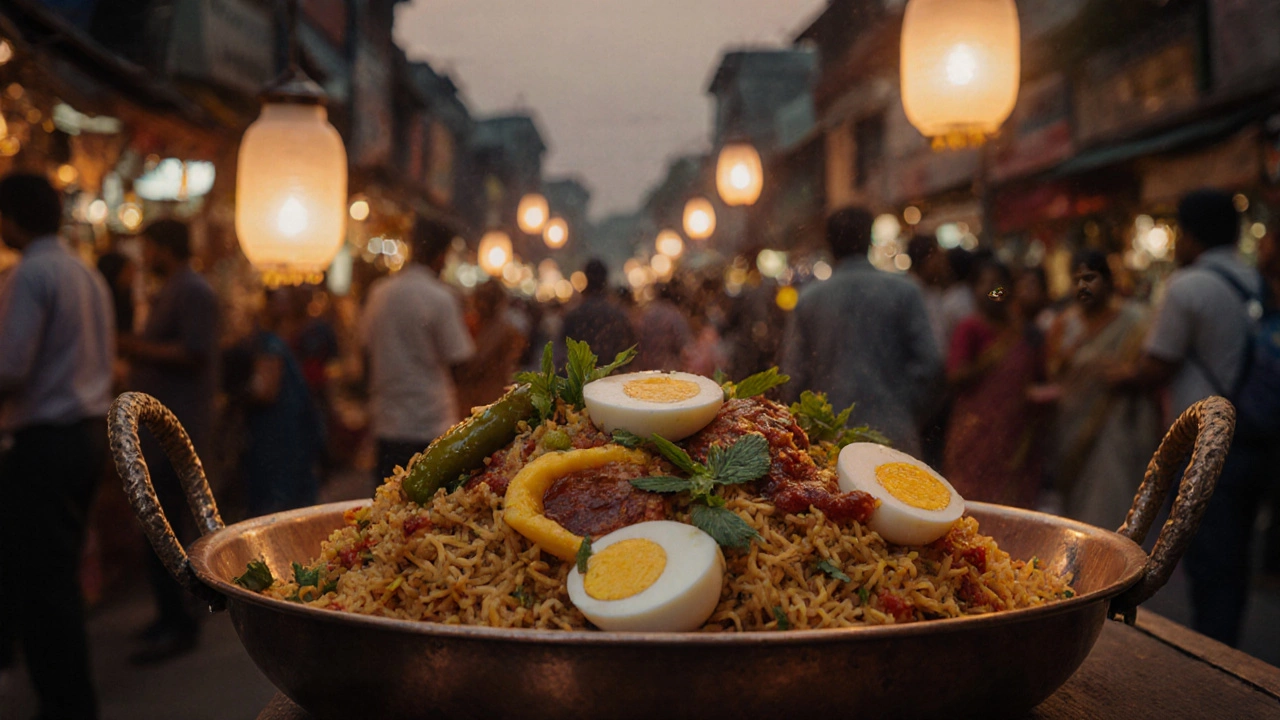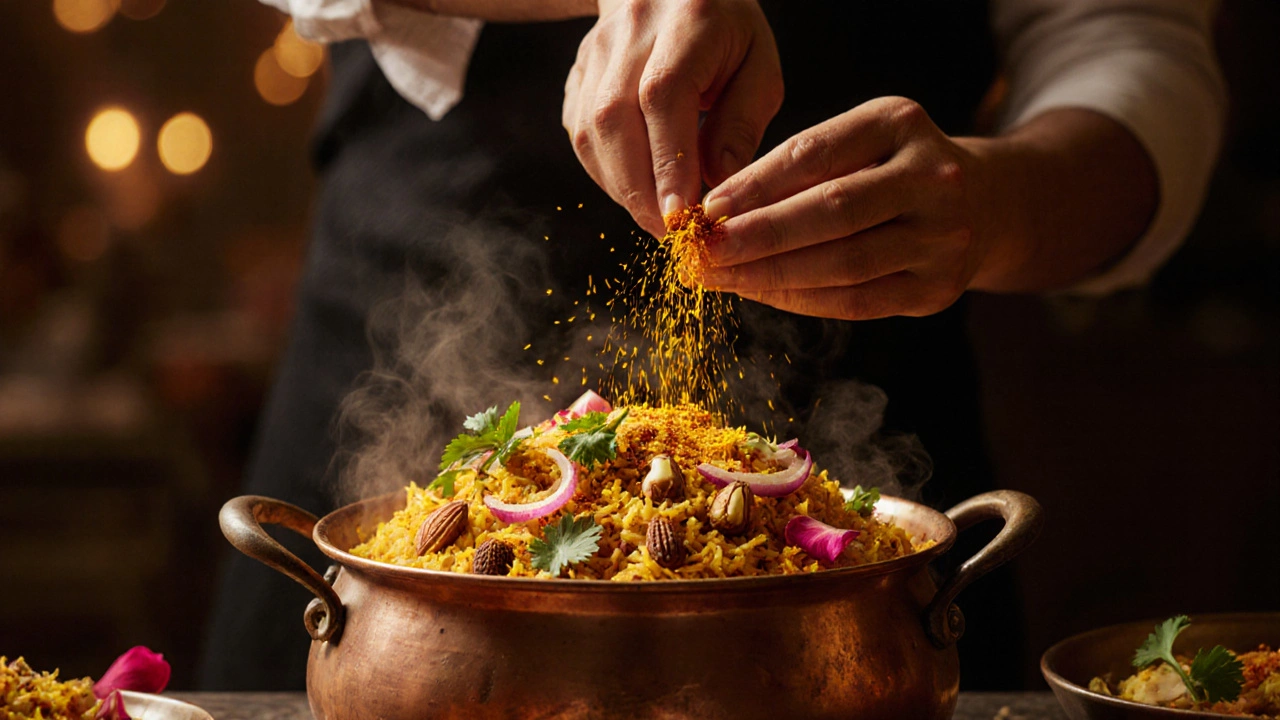Biryani Customization Tool
Customize your biryani recipe by selecting options below to enhance flavor, texture, and presentation.
Base Ingredients
Flavor Enhancers
Texture Boosters
Presentation
Biryani is a layered rice dish that combines aromatic basmati rice, marinated protein, and a blend of spices, traditionally cooked using the dum method. While classic recipes already wow the palate, a few smart tweaks can make it even more exciting without turning the kitchen into a laboratory.
Elevate the Base: Choose the Right Rice and Fat
The foundation of any great biryani is the rice. Basmati rice is a long‑grain variety known for its fluffy texture and fragrant aroma, with a typical length‑to‑width ratio of 6:1 and a low amylopectin content that prevents clumping.
Pair it with a high‑quality cooking fat. Ghee is clarified butter that brings a nutty richness and a higher smoke point (250°C) compared to regular butter, allowing the grains to fry briefly without burning. For a healthier spin, swap half the ghee for cold‑pressed coconut oil, which adds a subtle tropical note and boosts medium‑chain triglycerides.
Spice It Up: Aromatics That Change the Game
Classic biryani already uses a melange of cumin, coriander, and bay leaves, but you can add a few surprise stars. A pinch of saffron (about 0.05g) steeped in warm milk releases crocin, giving the rice a golden hue and a delicate floral taste that most guests remember.
For a smoky undertone, crush a few kasoora (dry fenugreek leaves) and sprinkle them over the final layer. The bitterness balances the richness of the meat and yogurt. If you love heat, fold in freshly ground madras curry powder (2tsp) for an extra kick without overwhelming the subtler spices.
Texture Play: Crunch, Cream, and Freshness
Contrast is key. Fry thin slices of onion until deep caramelized, then reserve a handful for a final garnish. The sweet crunch cuts through the moisture of the rice and meat, creating a pleasing mouthfeel.
Introduce creaminess with a dollop of strained yogurt (full‑fat, 5% milk fat). Whisk it with a pinch of salt, cardamom, and a drizzle of honey before mixing it into the meat marinade. The lactic acid tenderizes the protein while the subtle sweetness rounds out the spice profile.
For an unexpected pop, toss in roasted cashew nuts and golden raisins just before sealing the pot. The nuts add buttery richness; the raisins bring a bright, chewy surprise that makes each bite feel celebratory.
Visual Appeal: Colors That Tell a Story
People eat with their eyes first. Layer the rice with a gradient of colors: start with saffron‑stained rice, then a middle layer of turmeric‑golden rice, and finish with a top of bright green cilantro‑mint chutney. The green herb paste, made from equal parts fresh cilantro, mint, green chilies, and a splash of lime, not only looks vibrant but also lifts the flavor with citrusy freshness.
Scatter fresh pomegranate arils over the garnish. Their ruby burst adds a juicy, slightly tart pop and turns the dish into a festive centerpiece-perfect for celebrations.
Cooking Technique: Master the Dum and Beyond
Traditional dum cooking involves sealing the pot with dough or a heavy lid and cooking over low heat (around 90°C) for 30-45 minutes. To intensify aroma, line the lid with a layer of parchment paper brushed with ghee; the steam will pass through, infusing the rice with an extra layer of flavor.
If you’re short on time, try the ‘pre‑dum’ method: parboil the rice, then layer and seal the pot, but finish the cooking in a pre‑heated oven at 180°C for 20 minutes. This yields a consistent bake and frees up stovetop space.

Ingredient Swaps: Healthier or More Adventurous Options
Want a lighter version? Replace half the basmati with cauliflower rice. It absorbs the spices well and cuts calories by 40% while keeping the dish low‑carb.
For a vegetarian twist, use paneer cubes marinated in the same spice‑yogurt mix, or swap meat for jackfruit, which mimics shredded meat texture after long cooking.
Experiment with regional grains: try millet or quinoa for a nutty variation. Both have a slightly higher protein content (millet ~11g per 100g) and add a new texture profile that pairs nicely with the buttery ghee.
Regional Inspirations: Borrow From Other Biryani Traditions
| Region | Key Protein | Signature Spice | Unique Element |
|---|---|---|---|
| Hyderabad | Chicken or Mutton | Saffron | Layered fried onions + boiled eggs |
| Lucknow (Awadhi) | Raan (leg) | Kashmiri chilies | Slow‑cooked in sealed ‘dum’ with rose water |
| Kolkata | Eggs + Potatoes | Nutmeg | Subtle sweet‑savory balance, less heat |
| Malabar (Kerala) | Fish or Prawns | Coconut milk | Use of curry leaves and fried coconut flakes |
Pick one region’s hallmark ingredient and blend it into your everyday biryani. For example, add a splash of coconut milk and curry leaves to a chicken biryani for a quick Malabar spin. The result feels like a new dish while staying rooted in the biryani framework.
Presentation Hacks: Turn a Meal into an Experience
- Serve the biryani in a traditional handi (clay pot). The porous walls release subtle earthy flavors as the steam circulates.
- Place a small copper bowl of rose water next to the pot; let guests drizzle a few drops over their serving for an aromatic lift.
- Use banana leaves as a base layer inside the pot. They impart a faint herbal scent and keep the rice from sticking.
These touches make the dish look restaurant‑grade and invite conversation about the little details.
Quick Checklist for an interesting biryani ideas makeover
- Replace 25% of basmati with cauliflower rice or millet.
- Steep a pinch of saffron in warm milk; drizzle over the top layer.
- Mix yogurt, ginger‑garlic paste, and a spoonful of honey into the meat marinade.
- Fry onions twice: once to caramelize, once to crisp for garnish.
- Add roasted cashews, raisins, and pomegranate arils before sealing.
- Seal the pot with ghee‑brushed parchment for enhanced aroma.
- Finish with fresh cilantro‑mint chutney and a squeeze of lime.
Follow this list, and you’ll consistently serve a biryani that feels fresh, festive, and unforgettable.
Next Steps: Experiment, Share, and Refine
Start with one tweak-perhaps the saffron milk-and note how it changes the flavor. Then layer on another element, like the cashew‑raisin mix, and compare. Keep a simple journal: spice ratio, cooking time, and guest feedback. Over a few weeks you’ll develop a signature biryani that reflects your palate.
If you love a challenge, try a fusion biryani: blend Korean gochujang with traditional spices, or add smoked paprika for a Spanish flair. The sky’s the limit as long as you respect the core principle-layered, aromatic rice cooked slowly.
Frequently Asked Questions
Can I make biryani without meat?
Absolutely. Use paneer, tofu, jackfruit, or a mix of vegetables like carrots, peas, and potatoes. Marinate them in the same spice‑yogurt blend you’d use for meat, then follow the usual layering and dum process.
How do I prevent the rice from turning mushy?
Rinse basmati three times until water runs clear, then soak for 30minutes. Parboil it to 70% doneness (the grain should still have a bite). Draining well before layering ensures the final steam cooks it just enough.
What’s the best way to seal the pot for dum cooking?
Use a tight‑fitting lid wrapped with a dough seal, or line the rim with a strip of parchment paper brushed with ghee, then cover with a heavy plate and the lid. The seal traps steam, which is essential for the fluffy, fragrant result.
Is it okay to add fresh herbs like cilantro before cooking?
Fresh herbs lose their bright flavor when cooked long. Add them as a final garnish or blend them into a chutney that you spoon on top after the biryani is done.
How can I make biryani less oily but still flavorful?
Swap half the ghee for a neutral oil like avocado oil, and use low‑fat yogurt for marination. Adding a splash of coconut milk or a tablespoon of tomato puree also provides moisture without excess fat.
